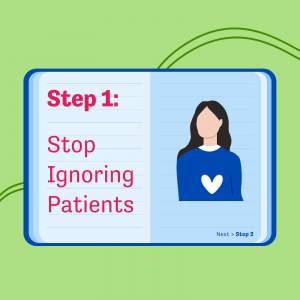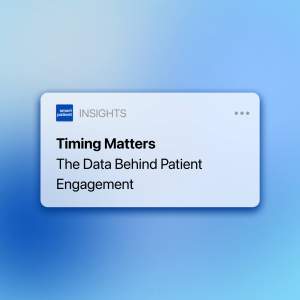Pharma Patient Activation Campaign: Stop Paying for People Outside of the Target Group
Pharma’s patient campaigns often fail to target relevant audiences effectively, meaning money is wasted reaching the wrong people. Read on to find out how activation campaigns run using our MyTherapy Campaign Engine can change that

- Pharma’s typical patient activation campaigns fail to target user groups effectively, meaning pharma pays for clicks from people outside the target audience
- Our MyTherapy Campaign Engine, combined with a seven-figure app user base, gives us the ability to target users living with certain diseases or taking specific medications much more effectively
- The app can also provide an additional layer of verification for patient activation, helping pharma get maximum value from its budget for activation campaigns
Pharma’s patient activation and education campaigns are typically aimed at a very specific group of people, such as those living with a certain disease or taking a specific medication. However, the methods used by many agencies running these campaigns for pharma fail to target audiences with high levels of specificity and provide little insight into user behavior beyond the click. Read how our MyTherapy Campaign Engine can help pharma improve its targeting and verification methods, thereby reducing the money spent on reaching people outside of the target group.
Why Pharma’s Patient Activation Campaigns Hit Wide of the Mark
In our experience, the majority of pharma’s patient activation campaigns follow a similar model. The campaign is built around a website designed to increase awareness of a topic, with typical marketing channels – such as social media and search engines – used to drive traffic to the site. The more traffic driven to the site, the more successful a campaign is considered.
While this sounds fine in theory, pharma’s reluctance to commit significant resources to these campaigns typically means they (and the agencies they use) adopt a simplistic model that has little in the way of audience targeting and uses simple measures, such as click-through rate (CTR) and cost-per-click (CPC), as performance indicators.
There are several reasons why this method is ineffective. In the first step, a lack of audience targeting restricts pharma’s ability to reach the correct patients. Considering the relatively small target audience, a ‘quality over quantity’ approach is necessary, as targeting the right people is more important than targeting a lot of people.
When it comes to analytics, CTR and CPC provide only a basic level of information regarding the performance of a campaign. Pretty visuals or catchy headlines might do an excellent job of enticing people to click, but their behavior beyond this is what is important. However, unlike e-commerce campaigns, for example, patient activation campaigns often lack a clear action that can be considered a ‘conversion’. Thus, no deeper metrics are used to validate the performance of a patient activation campaign.
The combination of these points results in campaigns that struggle to reach the right people and lack evidence of actual patient activation. More often than not, this means pharma is paying for clicks from people that fall outside the target audience.
How We Target the Most Relevant Users for Pharma’s Patient Activation Campaigns
Our MyTherapy Campaign Engine has been developed to take advantage of our different patient-facing channels to curate audiences for pharma’s patient activation and education campaigns.
We use a range of typical marketing methods, such as keyword targeting, along with retargeting efforts based on the behavior of users on the web. For example, we can drive traffic to our MyTherapy blog and create an audience of people who have spent a certain amount of time reading content about multiple sclerosis. This audience can be used for pharma patient activation campaigns relating to MS. This is representative of modern performance marketing methods, adapted to meet the needs of pharma to run effective, compliant campaigns.
Beyond that, the seven-figure user base of the MyTherapy app consists of communities of users living with almost every chronic disease. This allows us to push content to specific users within that group, such as those with reminders scheduled for drugs used to treat MS.
The combination of traditional marketing methods, specific retargeting audiences, and the MyTherapy user base gives us a powerful campaign engine designed specifically for the pharmaceutical industry.
This means pharma can be far more confident that the clicks they are paying for are truly meaningful.
USP: Using MyTherapy for Verifying Patient Activation
While our MyTherapy Campaign Engine can help pharma ensure that it is reaching the target audience with greater specificity than with typical agency-run campaigns, we can also use our MyTherapy app as a verification method for patient activation.
For example, we can track the number people that create medication reminders in MyTherapy having been exposed to the activation campaign, which can be a more accurate indication of a ‘conversion’. Our data science team can extrapolate anonymous data like this to estimate behavior flows, giving pharma much more information on how many patients are being reached by a campaign and greater insight into user behavior beyond the click.
By using MyTherapy as a verification tool for patient activation campaigns, pharma can benefit from more valuable information than simple metrics such as CTR and CPC can provide. Along with our effective targeting model, it makes our campaign platform uniquely suited to the needs of pharma.
If you want to speak to us in more detail about our patient targeting capabilities, verification methods, or any other aspect of patient activation and education campaigns run using our MyTherapy Campaign Engine, don’t hesitate to book a meeting.





